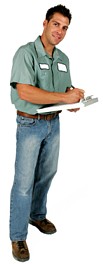Introduction to Fleas
Every pet owner understands the discomfort that can be caused by having fleas in the home. Fleas enter the home most commonly by feeding on dogs and cats, but humans can also be a host for the parasitic creatures. Having a flea-free home involves some understanding of how fleas thrive and reproduce.
Fleas are small, wingless insects which range from 0.08 to 0.17 inches long (2 to 4 mm) and are narrow when they are not feeding. Their bodies are covered with backward-facing spines which make them difficult to remove from the fur, hair, or feathers of the host animal. Fleas feed on blood, causing discomfort to the humans or animals on which they feed, especially those who have developed an allergy to flea bites.
Female fleas lay around 200 to 400 eggs on a host animal or on other surfaces. The eggs hatch into flea larvae, which resemble maggots. These larvae feed on various types of organic matter, including the feces of adult fleas. The larvae are also notoriously difficult to remove from the home, as they make their way deep into crevices of flooring and carpets. The fleas then pupate and emerge as adult fleas.
Adult fleas make up a very small amount of the total flea population - about 5%. This means that for every adult flea you see, there are likely 19 eggs, larvae or cocoons around. The fleas, in each stage of their life cycle, can usually be found in your pet's bed and immediate environment, but can make their way around your entire home.
When ridding your house of fleas, you must tackle each life stage. First of all, sweep, vacuum, dust, and mop frequently in all areas of your home, especially the areas frequented by dogs or cats. Eggs are generally laid on the animal and fall off as he or she moves. Pets should be treated, preferably with a flea treatment which kills fleas and makes them unable to reproduce. These insect growth regulators are often mixed with an insecticide, to kill fleas in all stages of their lives. Adult fleas can be removed from pets by flea baths and flea combs.
 Citrus sprays are available which contain linalool or limonene and can be sprayed on rugs, furniture, and carpeting. These sprays kill adult fleas but do not offer much protection against flea larvae and eggs. Boron-based products are available which kill immature fleas but not adult fleas. Pyriproxyfen and methoprene sprays control fleas in all stages of life. Most of these products require follow up treatments a week later to completely wipe out the flea population.
Citrus sprays are available which contain linalool or limonene and can be sprayed on rugs, furniture, and carpeting. These sprays kill adult fleas but do not offer much protection against flea larvae and eggs. Boron-based products are available which kill immature fleas but not adult fleas. Pyriproxyfen and methoprene sprays control fleas in all stages of life. Most of these products require follow up treatments a week later to completely wipe out the flea population.
Alternative flea treatments include diatomaceous earth, which causes the fleas to become dehydrated and die. Diatomaceous earth can be sprinkled around the house and vacuumed up after about a week. Dried pennyroyal can also be used as a natural form of flea control, as can cedar chips, although these are not as strong as commercial flea treatments. If you find yourself getting bitten by fleas, the bites on humans can be treated with hydrocortisone cream or any another anti-itch product.
Written by Bronwyn Harris
Related Home Institute Articles
